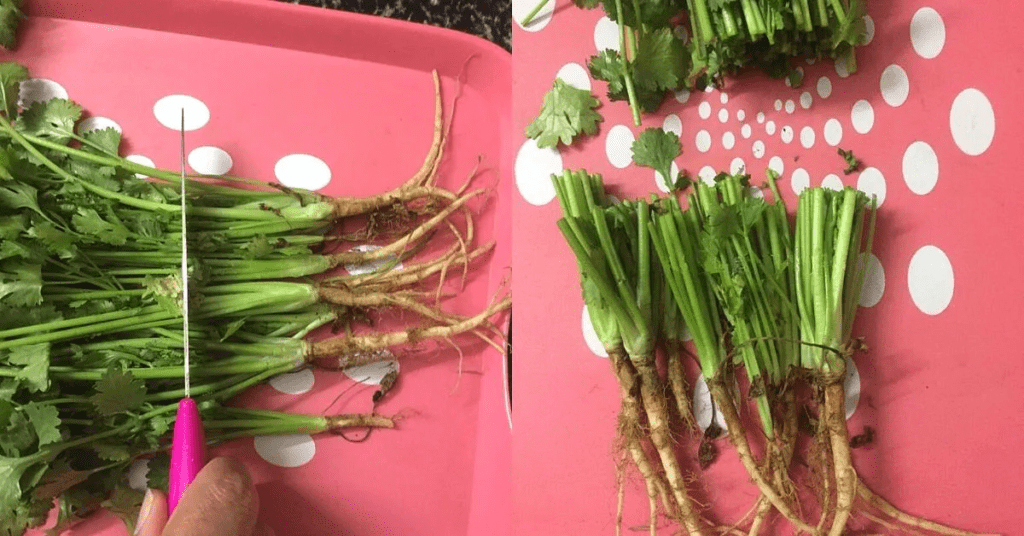We use coriander in all our foods in cooking. It is a vital ingredient in Indian food.
Coriander is well known because it has been used since 5000 Bc.
The coriander seeds are used in burials in 1550 BC. Romans and Greek physicians used coriander in their cooking.
Other names of coriander are Chinese parsley, dhania or cilantro. It acts as an anti-poisoning agent and helps in food digestion.
Their fresh leaves and seeds are used all over the world. It has a pungent flavour.
Coriander grows within a short span of 45 days. It has many medicinal benefits; it reduces the risk of heart attack, keeps the skin healthy, is the best medicine for the thyroid, and so on. In this article, we are going to know how to grow coriander at home from roots.

Varieties Grown For Larger Cultivation:
CO1, CO2, CO3, Gujarat coriander1,2, Rajendra Swati, RCR 41, Swathi, Sadhana
Many fresh herbs will grow easily from roots and stem when propagated in soil or water; hence coriander also will easily grow from roots and stem when planted in soil.
How to grow coriander/cilantro/dhania/ at home from roots:
Are you interested in growing fresh and aromatic coriander in the comfort of your own home? Growing coriander from roots is a very easy process.
With proper care and attention, you can easily grow coriander at home from roots by following the step-by-step procedure below.
Purchase coriander from a nearby store:
You can easily get the coriander from a nearby grocery store or a local farmer’s market. Choose roots that are strong and not wilted. Now cut at the root portion separately.

Choose the right container:
You can grow the coriander in a pot or container with proper drainage facilities. The container should be 6-8 inches deep and wide.
Fill the container with quality soil:
Coriander grows best in well-draining soil that is rich in organic matter. An equal proportion of soil+compost+sand to create a suitable growing medium.
Place the roots in the soil:
Fill a pot or a container with the prepared soil, and make a small hole in the centre. Place the coriander root in the hole and cover it with soil, gently pressing down to secure it in place.
Watering:
Keep the soil moist consistently but not soggy. Avoid soil dryness completely. In summer, frequent watering is needed to avoid soil dryness.
Place the pot under sunlight:
Coriander requires indirect sunlight to grow, so place the pot in indirect sunlight. A south-facing window is a good choice, as long as it doesn’t get too hot.
Fertilise regularly:
You can fertilise the plant for 2-3 weeks once with a balanced, water-soluble fertiliser. Add compost to the soil once a month.
Pruning:
Pinching the top portion of the leaves will encourage bushier growth.
Pest and disease management:
Regular plant monitoring will help avoid this pest and disease infestation. The initial stage of curing will help to prevent severe infestation.
Harvesting:
Within 15- 20 days, the coriander leaves will be ready to harvest. Cut the leaves from the top of the plant, leaving a few inches of stem. This will encourage the plant to continue growing.
Coriander seeds:
Coriander plants will produce seeds you can collect and use in cooking. To harvest the seeds, wait until the seedheads turn brown and start to split.
Cut the seedheads from the plant and place them in a paper bag to dry. Once the seeds are dry, you can remove them from the bag and store them in an airtight container.
Following the ten steps above, you can easily get your fresh coriander at home.

Major pest in coriander:
- Aphids feed the tender shoots and make holes in the leaves, resulting in leaves curling and wrinkling.
- Indigo caterpillars feed the coriander and turn the leaves into pale colour.
- Cutworms mainly attack the tender stem, and the plant automatically falls without balance.
Diseases:
- Powdery mildew directly affects the seed formation, and leaves turn white with powdery patches.
It is caused by the fungus – Erysiphe polygons.
2. Damping off- It leads to root decay and mainly attacks the ground level. We should select healthy root plants to avoid this disease.
How to control the pest and diseases:
Turmeric water has anti-fungal properties; mix turmeric powder in water and spray it over the plants to control pests and diseases.
Neem oil is an organic pesticide which controls both pests and diseases.
Coriander uses:
- Coriander helps lower blood sugar.
- It contains all vitamins and minerals and is rich in immune-boosting antioxidants.
- When consumed regularly increase heart health.
- It promotes digestion and gut health.
Frequently asked questions:
To grow the coriander, quickly plant seeds in a sunny area with well-draining soil. Water regularly and fertilise the soil with compost.
Thin out overcrowded seedlings and remove any yellow leaves to encourage healthy growth.Harvest leaves as needed when they reach a desirable size.
Yes, growing coriander in three days is possible using the sprouting method. To do this, you will need to soak coriander seeds in water for a few hours until they start to sprout.
Then transfer the sprouted seeds to a pot filled with soil, water them well, and place them in a sunny location.
The coriander sprouts should grow into mature plants within three days with proper care and a warm environment.
